This was published 2 years ago
Trans-Bhutan Trail: Epic, 400-kilometre hiking trail set to become one of the world's best
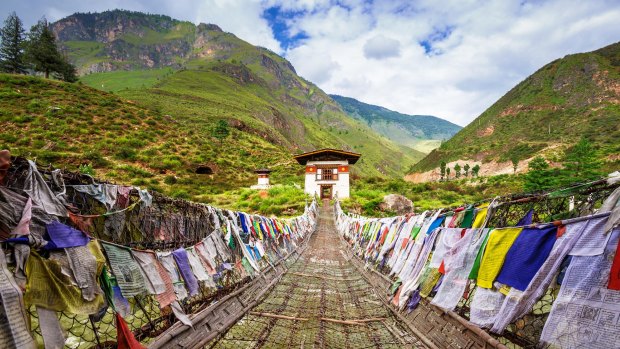
The Trans-Bhutan Trail, a more than 400-kilometre-long hiking track leads clear across the centre of the country.Credit: iStock
The legend of the "garps" looms large over Bhutan's national psyche. These ancient messengers were said to be fleet of foot and bold of character – they would run for days, from village to village, fortress to fortress, up mountains and through valleys, across streams and over vast meadows, to deliver vital news at a time when there was no other way to get a message through.
Some of these garps were inhuman in their abilities, according to local legend. The distances they could run, the speeds they could achieve – it didn't seem possible.
For centuries, from the 1500s all the way up until the 1960s, garps were Bhutan's lifeline, the way to connect a disparate country separated by hulking geographical phenomena. To send a message, to pass news, to call for help, you would use a garp.
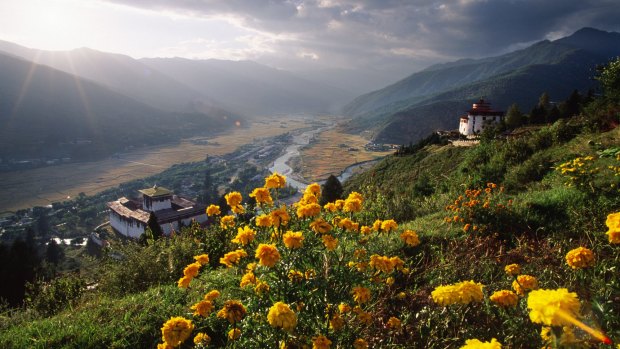
Paro valley.Credit: iStock
And so it doesn't seem a stretch to imagine that today, Lotay Tshering has the spirit of the garps pulsing through his veins.
The Bhutanese Prime Minister, a convivial, friendly man with a mischievous tilt to his smile, has all but disappeared into the thick pine forest just outside the national capital of Thimphu.
Tshering is leading an expedition on an auspicious day, heading up a long procession of politicians, public servants, journalists, monks and more who are all making their way through the steep hills to Dochula Pass high above.
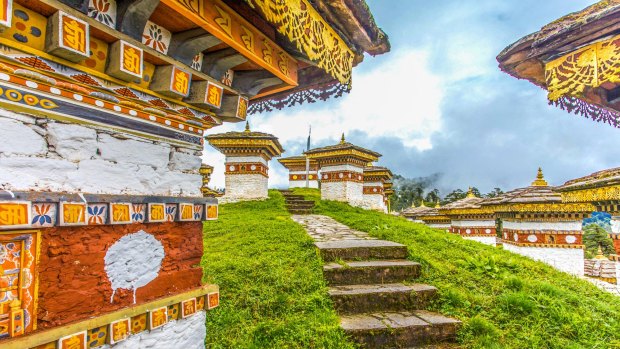
Stupas at Dochula Pass.Credit: iStock
However, rumour has it Tshering won't finish there. That 18-kilometre climb, from 2334 metres above sea level to 3100 metres is not enough for the Bhutanese PM. He plans to continue on to the town of Punakha, deep in a valley in the centre of the country, another 22 kilometres of hiking that will surely take him well into the night.
That's why we don't see Tshering again today. He's gone, well ahead, fleet of foot, bold of character. He skips past the ceremony planned in his honour at the top of the pass while the rest of us languish in the forest far below.
He descends down into the jungle on the other side and pushes on to Punakha, a place he will arrive at long after the sun has set and darkness has enveloped the valley, long after our cohort of foreign journalists has wheezed our way to Dochula and gratefully accepted plates of vegetable dumplings and cans of cold beer.

Every part of the track we walk seems connected to a story of some kind.
And he will do so out of respect. Because the pathway that those ancient garps once trod, the legendary trail that once stretched clear across Bhutan through territory both beautiful and inhospitable, has been rediscovered. Its entire 403-kilometre length has been revamped and reopened as a pathway that is destined to take a place as one of the great tourism experiences of the world. This will be one of the truly bold adventures, one that will test body and spirit and connect visitors to myth and mystery and place.
DAY ONE: PARO TO THIMPHU, 50 KILOMETRES, BY ROAD
The aerial approach to Paro is frankly terrifying. The Kingdom of Bhutan is legendary for its one international airport, situated in the only valley of this vertiginous country that is long enough for a large aircraft to safely approach and land.
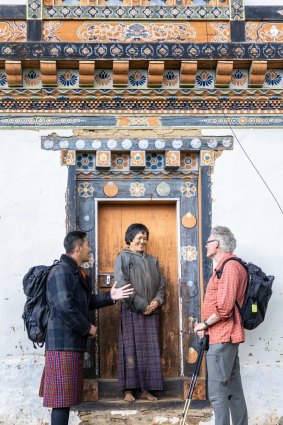
A local farmer in front of their farm house near Gangtey village.Credit: Ken Spence
Even so, the mountaintops are so close you could brush them with your fingertips as our plane soars through another valley and banks steeply before its wheels almost immediately hit the tarmac.
Paro hosts the airport but it isn't Bhutan's capital. That honour belongs to Thimphu, a friendly city a few hours' drive away, winding through the mountains on a narrow roadway that hugs the side of the hills.
Bhutan has eased its doors open once again to international tourism, after a pandemic-enforced closure. It returns refreshed and renewed though there have been changes. New visitor requirements mean tourists now pay $US200 ($312) a day for entry alone. This is a premium destination that has clearly doubled down on its "high value, low volume" mantra.
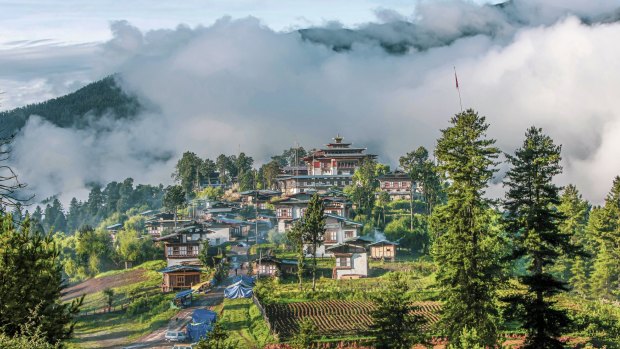
The 403 kilometres of the trail in total takes a good 28 days to complete.Credit: iStock
Something else has changed, too: the kingdom has a new attraction, the Trans-Bhutan Trail, a more than 400-kilometre-long hiking track leading clear across the centre of the country, an epic pilgrimage that calls through rural villages and past towering ancient fortresses, past monasteries and temples, over high mountain passes and across rushing glacial rivers, along vast meadows and through thick jungle.
This will no doubt soon rank with Spain's Camino de Santiago, the US's Appalachian Trail, and Japan's Kumano Kodo as one of the world's great long-distance hiking trails.
This trail is new, but it is also ancient. This was the major artery used for transport and communication in Bhutan as far back as the 16th century, though one that began falling into disuse and disrepair with the advent of the country's East-West Highway in the 1960s. Suddenly, there were cars; no one needed to walk anymore. The trail was essentially lost.
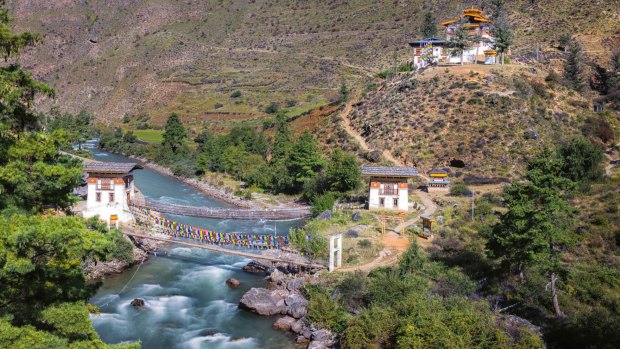
The Tachogang Monastery.Credit: Ken Spence
"That pathway was created by pilgrims, soldiers and traders, both Bhutanese and Tibetans," says Sam Blyth, a Canadian philanthropist and founder of, and driving force behind, the Trans-Bhutan Trail. "They would have found villages in these valleys that were isolated for so long that they had distinct dialects and religious beliefs, unknown even to people in the next valley."
Some of us learned to make sourdough during the pandemic. The Bhutanese carved a 403-kilometre hiking path clear through the middle of their dense, mountainous nation.
The process of rediscovering that trail, and then preparing it as a tourist attraction, was an arduous one, though one the Bhutanese achieved in a phenomenally short time, creating almost the entire trail during the three years of COVID-19 shutdowns.
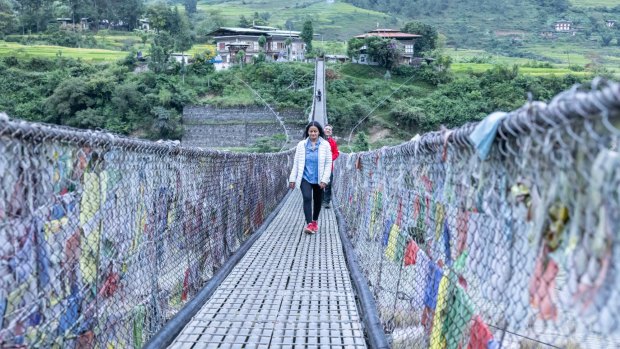
The 150 metre suspension bridge across the Tsang Chu River at Punakha.Credit: Ken Spence
"There was very little written record or mapping when we started to research this trail, particularly in the central and eastern areas of the country," says Blyth, who I meet on my arrival in Thimphu. "So, we held town hall meetings along what we thought was the route, to talk to the local people and get their input, to get elders' stories of the trail.
"From this came an almost archaeological project that revealed rutted pathways, worn stone steps, old signposts, and all kinds of religious icons. Many stairways had subsided, many bridges collapsed. More than 10,000 stone steps had to be cut and installed for this trail, 18 new bridges built, and this over 115,000 feet (35,000 metres) of vertical."
I can see that vertical, that unyielding up and down, from my hotel room. You can't miss the mountains in Bhutan. These Himalayan "foothills", several of which rise above 7000 metres, are ubiquitous. Soon, I will be treading in the footsteps of the ancient garps though no doubt at a gentler pace.
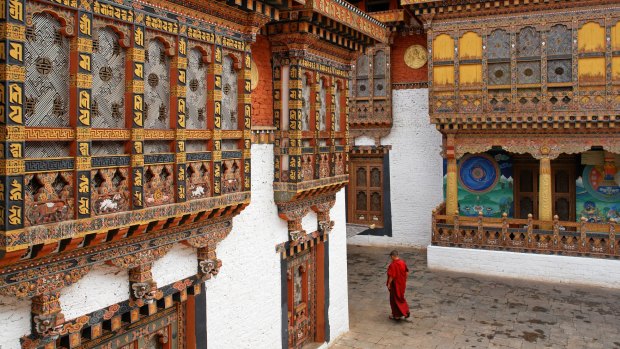
A temple in Punakha.Credit: iStock
DAY TWO: DOCHULA PASS TO CHANDANA LHAKHANG, 13.5 KILOMETRES, ON FOOT
Those 403 rollercoaster kilometres in total take a good 28 days to complete, and carry hikers through some of the most remote terrain that this already remote country has to offer. So no, I will not be hiking the entire Trans-Bhutan Trail. Instead, I will be tasting its highlights.
I'm travelling with G Adventures, the Canada-based travel company which has close ties with Sam Blyth and his Trans-Bhutan Trail organisation. This has allowed it to be one of the few offering guided itineraries on this new attraction.
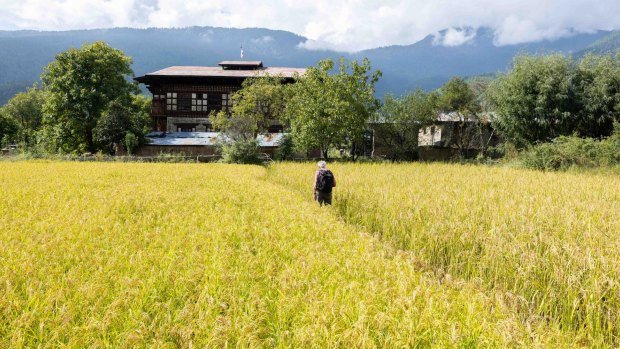
The Trans Bhutan Trail passes through fields near Paro.Credit: Ken Spence
The sample I'm getting is a mix of G's two Trans-Bhutan Trail itineraries, which blend days of hiking (and nights of camping), with cultural activities and other Bhutanese highlights.
The first section of trail we're tackling is all downhill. Starting from Dochula Pass, which we will revisit later in the week, we're descending down through the cloud forest 14 kilometres to Chandana Lhakhang, a temple complex far below at a sub-tropical 1500 metres above sea level.
You can measure the changes in scenery and surroundings here not so much in distance travelled forward but distance travelled down: the trees become denser as we march ever lower, the undergrowth wetter, the birdsong louder.
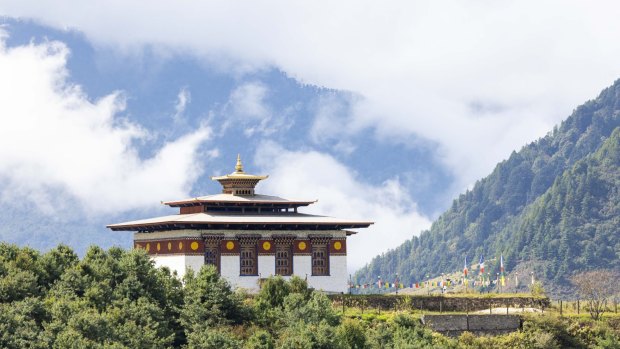
A Buddhist nunnery in the Phobjikha Valley.Credit: Ken Spence
Monkeys swing from branches in the lower reaches. Leeches wiggle their way up boots. Clouds appear far below you, and then around you, and finally high above.
The trail looks every bit fresh and new. It hasn't yet been trampled by millions of pairs of feet, in the same way it was during its hundreds of years of original existence. It's narrow and unwieldy, challenging and yet beautiful, ever-changing as new views appear every few minutes through gaps in the forest canopy.
This is our first experience of the true beauty of the Trans-Bhutan Trail: not only of its scenery but its stories, too.

Buddhist monks at the Paro Dzong.Credit: Ken Spence Melbourne AUSTRALIA
"Each pass has its own unique tales, each its own myths," says Dorji Bindha, our local guide on this journey. Blyth agrees: "This trail is surrounded by mythology. If you talk to the elders they will tell you stories about ghosts, and that's connected to a lot of the religious constructions here, because they built those to satisfy these evil spirits."
Every part of the track we walk seems connected to a story of some kind. Some of these tales are wildly mythical, some firmly rooted in recorded history, while many others fall somewhere in between, their veracity impossible to decipher.
This part of the trail, from Dochula down into the valley, was traditionally used by monks when they migrated from their winter residence in Punakha to their summer residence in Thimphu.
It's also a pathway that was famously walked by the "Divine Madman", a historical figure whose legend lives on in the form of the quite graphic phalluses you see painted prominently on the side of Bhutanese houses.
The story goes that the monk fired an arrow from Tibet, and then followed its path to today's destination, Chandana Lhakhang, where he would take a wife. He would also go on to practice a sexually obsessed form of Buddhism, the legacy of which is clear on those walls.
Myth, wrapped in legend, with perhaps a grain of truth buried deep within. Like the clouds that hang ever-present on the mountaintops here as we trudge down towards the temple, you have to wait patiently for a chance to glimpse what lies beneath.
DAY THREE: PELELA PASS TO CHENDEBJI, 20 KILOMETRES
Dawa Tshering remembers the old trail. He walked it as a young boy, hefting sacks of rice and salt between villages. He would travel in a large group back then, more than 30 people together with their horses.
They would sing, Tshering says, as they lugged their loads up and down the hills. They used to stay up late at their campsites, eating together, singing together and dancing well into the night.
Watching us walk that same trail again today, hiking the 20 kilometres from Pelela Pass to Chendebji, laughing and gaping at the beauty and the wonder of it all – Tshering says it takes him back. He wishes he could return to those times.
Tshering is a village elder now in Rukubji, a small settlement below Pelela Pass. The 73-year-old is one of the last living links to the old Trans-Bhutan Trail, the original trail, one of the few people left who walked it.
Tshering was consulted during the creation of this section of the new track, to find where it once ran, to rediscover the pathway, and to retell all those old stories.
Today he leads our group. He's dressed traditionally in the flowing red robes favoured by the Bhutanese, though his feet are clad in heavy gumboots, which should be a fair indication of the terrain we will be tackling.
This is another downhill section of the trail, which begins by meandering through vast alpine meadows frequented by yak herders in the colder months, before following the course of a river on a muddy path down into Rukubji.
We take lunch in a local house in Tshering's village, a typical Bhutanese spread of vegetable stews laden with fiery chillies (the Bhutanese national dish), served over rice. This is the sort of thing you can expect to find throughout the length of the trail: accommodation in local guesthouses or under the stars in campsites; food cooked in the villages; everything done the way it has been for centuries.
There were tigers seen near the track we're walking on today, two of the Bengal species that flourish in these dense and mostly uninhabited mountains – though they're rarely spotted out in the open. Two local guides are detailed to walk with us down to Chendebji, keeping an eye out for apex predators on the prowl.
There are no sightings and we reach our campsite, in a clearing near a school in Chendebji, undisturbed. We sit around a crackling campfire and drink tea and swap stories of our own, already swept up in the romance of the trail, in the inspiration it provides to wax lyrical about your own adventures, to tell your own wildly embellished tales.
DAY FOUR: THIMPHU TO DOCHULA PASS, 18 KILOMETRES
Suddenly, we're back in Thimphu. Although by "suddenly" I mean via a five-hour drive doing about 20 kilometres our mini-bus along Bhutan's notoriously wiggly highway, above yawning abysses that you do your best to ignore.
Ordinarily G Adventures groups would continue their Trans-Bhutan Trail adventures on foot from Chendebji, hiking on to the cultural hub of Trongsa, with its spectacular dzong, or fortress, and further to rural Gyetsa, and then to another towering dzong in Bumthang in central Bhutan.
We, however, have to return to the capital for the ceremonial opening of the trail, hosted by the Bhutanese king's brother, Prince Jigyel Ugyen Wangchuk, and Prime Minister Tshering.
There's a short ceremony at Simtokha Dzong, an important fortress turned temple on the outskirts of Thimphu, before the group sets off on the 18-kilometre hike up to Dochula Pass. Blyth is one of the hikers today, realising a long-held ambition which can be traced to 1988.
"It was a magical time," he recalls. "We went into villages that had seen very few foreigners and I really fell in love with the country. It was at that time that I first heard of this mysterious trail that traversed the country, and that even as children people had walked to go to school, to go on pilgrimages. I always dreamt of walking that trail.'
That nation's political leader has soon disappeared into the forest again as he charges, fleet of foot and bold of character, up to Dochula Pass and beyond to Punakha. The legacy of the famous garps runs through his veins.
The rest of us may not have quite that same spirit, but still we tread in those messengers' ancient footsteps, we revel in their stories, we claim our place among the legends.
The writer travelled as a guest of G Adventures.
THE DETAILS
TOUR
G Adventures operates two all-inclusive tour itineraries on the Trans-Bhutan Trail: "Camp the Trans Bhutan Trail", an 11-day tour with a mix of camping and hotel stays, from $6099 a person; and "Highlights of the Trans Bhutan Trail", a 12-day itinerary staying in hotels and guesthouses, from $7399 a person. (Both tour prices include the daily Sustainable Development Fee, see details below). See gadventures.com
FLY
Bhutan's national airline, Druk Air, is the sole commercial carrier taking travellers into Paro, the country's only international airport. Druk operates from Bangkok, Singapore, Kathmandu, Dhaka, and multiple Indian ports. See drukair.com.bt
ENTER
Bhutan's complicated and costly visa system has recently changed. The kingdom used to charge $US65 a traveller per night for what it calls its Sustainable Development Fund (SDF), with a minimum spend per traveller of $US250 a night into which the SDF fee was included. In July this year, the SDF levy was increased to $US200 a person per night, exclusive of any other expenses. That means all food, accommodation, transfers, entry fees and more have to be paid on top of the amount. There's also a $US40 a person fee to apply for an entry visa. Visa applications and SDF payments can either be done privately, or through a registered tour operator. See bhutan.travel or tourism.gov.bt
MORE
FIVE MORE ATTRACTIONS TO SEE IN BHUTAN
PARO TAKTSANG
The 300-year-old temple complex otherwise known as the "Tiger's Nest" is without doubt Bhutan's most famous site, and deservedly so. This group of four main temples and residences sits in a spectacular and impossibly beautiful location midway up a sheer cliff 900 metres above the valley floor in Paro. See bhutan.travel
PUNAKHA DZONG
This vast and impressive fortress-turned-temple sits between two rivers, and was once the seat of the Bhutanese government. Punakha is the second-oldest and second-largest dzong in Bhutan, and one that now houses the sacred relics of the Kagyu school of Tibetan Buddhism. It's also one deeply traditional and beautiful place. See bhutan.travel
NATIONAL MUSEUM OF BHUTAN
Established in 1968 in Paro, and set in an ancient dzong, the National Museum of Bhutan houses more than 3000 works of Bhutanese art, from bronze statues to sculptures to paintings, covering more than 1500 years of the nation's history. See nationalmuseum.gov.bt
TRONGSA DZONG
Bhutan's largest fortress, built in the 1600s and later vastly extended, is built atop a mountain spur overlooking the Mangde River in central Bhutan. It's been put forward for UNESCO World Heritage classification and is still home for more than 200 Buddhist monks. See bhutan.travel
CHIMI LHAKHANG
You don't have to spend long in Bhutan before you begin hearing stories of the "Divine Madman", the monk Drupka Kunley, whose sexualised version of Buddhism can still be seen in the phalluses painted on walls throughout the country. Chimi Lakhang, near Punakha, is a monastery founded by Kunley, a sacred site for the Bhutanese that houses the original wooden phallus said to have been brought by Kunley from Tibet. See bhutan.travel
Sign up for the Traveller Deals newsletter
Get exclusive travel deals delivered straight to your inbox. Sign up now.